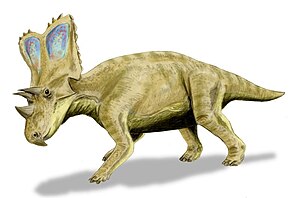Coronosauria
| Coronosauria | ||||||||||||
|---|---|---|---|---|---|---|---|---|---|---|---|---|

Reconstruction of Chasmosaurus |
||||||||||||
| Temporal occurrence | ||||||||||||
| Upper Cretaceous ( Turonian to Maastrichtian ) | ||||||||||||
| 93.9 to 66 million years | ||||||||||||
| Locations | ||||||||||||
| Systematics | ||||||||||||
|
||||||||||||
| Scientific name | ||||||||||||
| Coronosauria | ||||||||||||
| Sereno , 1986 |
The Coronosauria are a taxon of the dinosaurs within the Ceratopsia .
In this group, which was defined by Paul Sereno in 1986, the more highly developed representatives of the Ceratopsia are summarized, including the Protoceratopsidae , the Leptoceratopsidae and the Ceratopsidae .
One of the characteristics of this group is that the part of the skull in front of the eye socket is elongated and is more than half the length of the actual skull (without the neck shield). The atlas , axis and other cervical vertebrae are fused ( syncervical ) to better support the weight of the enlarged head. Like all Ceratopsia, they are characterized by the narrow, beak-like snout made of rostral bones and predentals . They have a neck shield consisting of the parietal and scale bones . Like all Ceratopsia, they were herbivores.
All Coronosauria finds come from the Upper Cretaceous (approx. 94 to 66 million years ago) and were found in East Asia and North America.
The Coronosauria form together with some primeval representatives ( Archaeoceratops , Auroraceratops , Liaoceratops and Yamaceratops ) the taxon of the Neoceratopsia within the Ceratopsia. A possible coronosauria cladogram (based on You & Dodson, 2004) looks like this:
| Coronosauria |
|
||||||||||||||||||
|
|
The internal system of the Coronosauria is, however, controversial. According to other studies, the Leptoceratopsidae form the more basal group and the Protoceratopsidae are more closely related to the Ceratopsidae.
literature
- You Hailu, Peter Dodson : Basal Ceratopsia. In: David B. Weishampel , Peter Dodson, Halszka Osmólska (eds.): The Dinosauria . 2nd edition. University of California Press, Berkeley CA et al. 2004, ISBN 0-520-24209-2 , pp. 478-493, digitized version (PDF; 807.25 kB) .